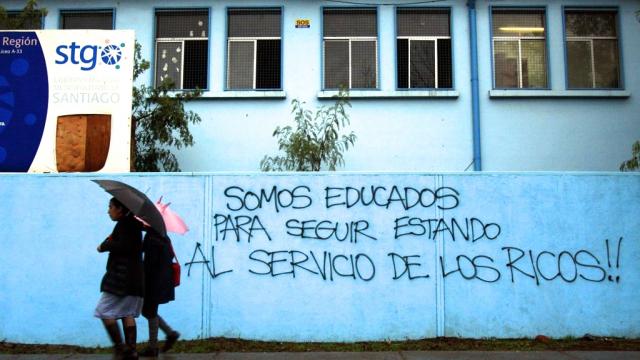
The next few months are of critical importance to Chile’s long-running education movement. President Michelle Bachelet has said she plans to implement comprehensive education reform this year, which will guarantee quality education for everyone. To ensure this happens, the movement has increased pressure on the government with huge protests by teachers and students last month, including an indefinite strike by the National Teachers Union that began June 1.
Over the years, the movement has learned to temper its expectations. In 2011 — when protests were last at a peak — many thought change was imminent, only to suffer frustration and loss of momentum in the years that followed. But this time may be different.
According to Bill Moyer — a social change activist and founding member of the Movement for a New Society, a network of activist collectives that played a key role in nonviolent social movements in the 1970s and 1980s — movements often go through eight stages. Based on the model he designed for understanding the cycle of a social movement — called the Movement Action Plan, or MAP — the education movement in Chile is nearing the final stages. Before learning about those, however, it is important to understand how it got to this point.
Students have historically been at the forefront of social protests in Chile. High school students were some of the first to defy Augusto Pinochet’s military dictatorship, while university students used their campuses as safe places for resistance. After the end of Pinochet’s regime the student movement took time to re-focus their demands and set up new forms of organization and protest.
Following this process of re-adjustment, high school students sparked Chile’s movement for education in 2006 — known as the “penguin revolution” because of the shape and color of the school uniforms — with a very specific demand for free and universal student transport passes. They soon moved on to more structural demands against the neoliberal economic policies affecting education, specifically the Organic Constitutional Act of Teaching, which reduced state involvement in education and came into force on the last day of Augusto Pinochet’s military dictatorship on March 10, 1990.
The movement was briefly successful in putting education on the political agenda. Mobilizations came to an end after President Bachelet — during her first term in office from 2006 to 2010 — repealed the controversial act. However, the demand for free, quality public education, was still far from being met.
At this point, the movement entered stage three, or “ripening conditions,” where people form new groups and small civil disobedience actions start to dramatize the problem. After the 2006 protests there was a period of lower activity within the movement, but slowly new collectives began to emerge, along with a clearer demand for radical transformation of education in Chile.
The movement was then ready for the fourth stage, or “take off.” This usually happens after a trigger event — caused by the movement itself or by the power-holders — and, after significant organizing, which leads to massive demonstrations, large acts of civil disobedience and extensive media coverage.
In Chile, the trigger was the 2010 election of Sebastián Piñera, the country’s first right-wing president since Augusto Pinochet was forced out of office. Piñera’s government came to power as a reaction to years of frustration with the Coalition of Parties for Democracy — the center-left coalition that had been in power since the end of the Pinochet dictatorship. This development, combined with a growing perception that real social justice would not come from the top down, created stronger unity on the left to organize against the government.
Student organizers, who represented the many thousands of young people eager to engage politically by creative means other than the ballot box, understood that the time was ripe for massive mobilizations.
The movement then launched a campaign that involved a great diversity of actions, including mass marches, school occupations, flash mobs, an alternative referendum on whether education should be free and much more. Most of the student protests were heavily repressed by the police. The government tried to blame the violence on the students, but the images of students, teachers and parents marching peacefully being tear gassed and hit by water cannons belied this narrative. This repression backfired, as polls showed that the movement had more than 70 percent approval among the public, which put education at the top of the political agenda in 2011.
At the time there was a feeling within the movement that it was possible to change things immediately, but as Moyer argues, change takes time and movements usually have to go through various stages before achieving their goals. One weakness of the student movement is that it is very dependent on the school year. Students struggle to keep the momentum going during the summer break and every year there is new student leadership.
Between 2012 and 2014, the movement went through the fifth stage, which Moyer calls the “perception of failure.” In this stage, there is a lower level of participation in actions and the movement appears to be having less of an impact. Many participants felt that large protests weren’t bringing about real change in education and that it was time to look for new strategies.
There were also divisions among those in the movement, most notoriously manifested in the different positions taken by activists on voting — first in the 2012 local elections and later during the 2013 presidential and parliamentary elections. While many of the university student leaders strongly supported voting for different candidates to local government — and some even ran and got elected to parliament themselves — the high school student leadership could not have been more different. They called for a boycott of the elections, arguing that no real change would come through electoral politics.
During the fifth stage, politicians often argue that they have “received the message of the people” and that now it is their turn to design and implement the changes that the people have demanded. For the Chilean student movement, this meant that the debate moved from the streets to Congress and the political parties.
At the same time, the mainstream political conversation was dominated by the presidential elections of 2013. Many people had hoped Michelle Bachelet’s re-election would come with a mandate to radically reform the education system. Bachelet had finished her first presidential term in 2010 with historically high approval rates, thanks to economic measures that — in a limited, but direct way — supported working-class people. The main message of her 2013 presidential campaign was a commitment to end inequality in Chile.
Since her re-election, however, Bachelet has failed to put forward education proposals that actually meet the movement’s demands. The government argues that this is not due to a lack of political will, but rather the limited resources of a stagnant economy. To implement and be able to afford their education reform, the government passed tax reform last year, with the goal of raising more taxes from big companies. To many, however, this reform fell short of the promise to end inequality in the country. Chile doesn’t lack resources, what it lacks is a just distribution of wealth.
At present, the movement is in the sixth stage, which Moyer called “winning over the majority.” After more than a year of Bachelet’s government, the movement is clear that the radical change they demand for free, quality public education, will not come through the reform that this government is proposing. The government reforms face strong opposition in Congress, so the government has had to water down their proposals to make sure they get approved.
The movement understands that it is now vital to work on proposals that counteract those put forward by the government and use its power to secure as good a deal as possible, knowing that it will not be the end of the struggle.
While there have been proposals for reform from students and teachers over the years, they have become more important than ever now that the government is sending education bills to Congress. On June 6, the Chile Student Confederation, which represents students from the so-called “traditional” universities — public schools that were privatized by Pinochet — agreed on an education proposal called “Chile decides.” It put forward a petition with nine points, including: the development of curriculum by teachers, stability for workers, internal democracy for schools, free and universal education, and an end to profit in education in all its forms.
The proposals have been accompanied by growing social pressure. In June, there was an increase in the regularity and the number of people at marches. For instance, the protest organized by students on June 10 mobilized almost 350,000 people throughout Chile. These actions are happening at the same time as the indefinite teachers’ strike is taking place.
According to Moyer, there are two stages after the sixth: “success” and the “consolidation of success and moving over to other struggles.” Even though these stages are not necessarily linear, and not all movements go through all of them, it is a model that attempts to make sense of the processes experienced by a movement and to ultimately show that change takes time.
The education movement in Chile is at a historic point, having already gone through several stages of a long struggle. It wouldn’t be in the position it is now — with Bachelet’s government set to reform the Chilean education system this year — if not for continuous organizing and creative actions.
The movement is aware that this is a crucial moment and it has raised its level of mobilization accordingly, knowing it is possible that the government might make compromises on many of their demands in response to pressure from more moderate sectors. However, if the movement manages to gain majority support — as it did in 2011 — it may be able to secure free, quality public education for everybody in Chile at last.
3 WAYS TO SHOW YOUR SUPPORT
- Log in to post comments















